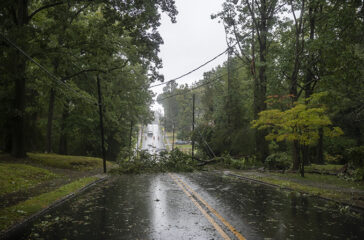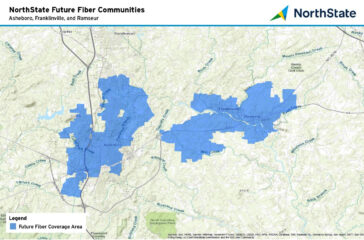Biggs wins District 70 seat
ASHEBORO — Republican Brian Biggs has won election to represent District 70 in the N.C. House of Representatives. He defeated Democrat Susan Scott. Biggs is currently a member of the Randolph County Board of Education.

ASHEBORO — Republican Brian Biggs has won election to represent District 70 in the N.C. House of Representatives. He defeated Democrat Susan Scott. Biggs is currently a member of the Randolph County Board of Education.

ASHEBORO — Rep. Richard Hudson (R-NC08) will return to the U.S. House as the representative for North Carolina’s Ninth Congressional District based on unofficial results Tuesday night.
With about two-thirds of the precincts reporting, Hudson had more than 80% of the vote in a lopsided victory over Democratic candidate Ben Clark.
After a three-judge panel redrew Congressional maps for North Carolina, Hudson announced he would run in the new ninth district that includes Chatham, Cumberland, Harnett, Hoke, Lee, Moore, Randolph, Richmond, and Scotland counties. Hudson is in his fifth term in the U.S. House serving the N.C.’s eighth congressional district.
Randolph County has been represented by Ted Budd (R-NC13) since redistricting placed the county in the 13th District. Budd was elected to the U.S. Senate Tuesday night.

Randolph County Sheriff Greg Seabolt was an overwhelming winner to keep his position.
Seabolt was racking up more than 80% of the votes compared to opponent Sean Walker.
In the Randolph County Board of Commissioners race in District 4, Hope Haywood was a huge winner. Kimberly Walker was the opponent.
Commissioners chairman Darrell Frye and David Allen, who withstood a primary challenge, were unopposed in keeping their positions.
The top vote-getter for Randolph County School System’s board of education was Shannon Whitaker. Three spots were at stake, with Phillip Lanier and Fred Burgess in good positions to secure the other two spots, with David Carter running fourth.
For Randolph County Soil and Water Conservation District Supervisor, the winner was Brian Ward. He was well ahead of Carrie Guess-Slatosky.

The election sites, like this one in Asheboro, were busy at times during the past couple of weeks. (PJ Ward-Brown/Randolph Record)
Almost 27,000 residents cast ballots during early voting in Randolph County in advance of this week’s general election.
The turnout proved particularly heavy on the final days.
Of the 15 days used for early voting in the county, three of the heaviest four turnouts came in the last three days.
The high total was Friday’s 2,742. Next was Oct. 24 – the fourth day of early voting – with 2,080.
The third busiest day was Thursday with 2,068 and followed by Saturday’s total of 2,018 on the last day.
Election Day is Tuesday. Voters must vote a designated precinct on this day.
Four sites were used for early voting. For each day, the highest turnout was at the Randolph County Board of Election headquarters in Asheboro.
The second-busiest local was the Braxton Craven School in Trinity. Randleman Civic Center was the third most-used voting location for every day, though Franklinville United Methodist was close behind on some days.
The numbers for Randolph County were similar to 2018, which was the last mid-term election. That year, there were 26,432 early voters in the county.
Four early voting sites were used, though a couple of the locations were different.

RALEIGH — The two North Carolina Supreme Court seats up for election in November have taken on extra significance as the outcome could flip the court’s partisan makeup during a period of political polarization.
Registered Democrats hold a 4-3 advantage on the court, but Republicans would retake the majority for the first time since 2016 should they win at least one race. The seats carry eight-year terms, so barring unplanned retirements, Republicans would be assured of keeping the upper hand for at least 4 1/2 years if successful.
Outside groups are spending big to influence the races. In the two largest television markets alone, two super PACs have committed spending roughly $3 million on ads, according to documents filed with the Federal Communications Commission.
In keeping with nonjudicial elections this year, ads have focused on crime and abortion.
Court of Appeals Judges Richard Dietz, a Republican, and Lucy Inman, a Democrat, are looking to succeed retiring Associate Justice Robin Hudson. And Associate Justice Sam Ervin IV, a Democrat, is seeking reelection against Republican Trey Allen, currently general counsel for the state court system.
State Republican Party materials label Allen and Dietz as “conservative judges.” And at a recent Democratic Party rally, Gov. Roy Cooper urged Inman and Ervin’s election “because they are going to be fair and follow the law.”
Beyond usual legal conflicts, justices could hear challenges to policies enacted by a Republican-controlled General Assembly that could earn veto-proof majorities in November. Those could include legislation on voting, guns and abortion that Cooper has stopped by threatened or actual vetoes since 2019. Lawmakers also must redraw congressional districts, which aren’t subject to veto.
North Carolina Republican leaders plan to consider further restrictions on abortion in 2023 but haven’t reached a consensus.
The liberal-leaning North Carolina Families First PAC jumped on the abortion issue, running a television ad accusing Allen and Dietz of having “extreme views” that “could allow lawmakers to criminalize abortions, forcing women and girls to give birth.”
Judges and judicial candidates are subject to rules designed to ensure impartiality on issues they could rule on. Allen and Dietz said they would approach any case without presumptions on how they’d rule.
“When I see ads like that, I am disappointed because I think it is reinforcing this idea to the public that judges have already made up their minds,” Dietz said.
Commercials from the outside group Stop Liberal Judges contend one ruling written by Inman and another agreed to by Ervin that blocked certain convicted child sex offenders from being tracked electronically for decades are proof they’re “not protecting our children.”
Inman, who joined the Court of Appeals in early 2015 and ran unsuccessfully for Supreme Court in 2020, called them a “false and misleading smear” that belies her record as both a trial and appellate judge.
“It is wrong and the antithesis of the law to exploit child victims for political gain,” she said.
The elections come near the end of a two-year court term marked by several high-profile split decisions — favoring the Democratic majority — involving redistricting, voter ID and criminal justice cases.
Democratic politicians and allies have praised such majority opinions as victories for equality and justice. Dissenting opinions from Republican justices have been acerbic at times, accusing the other side of judicial activism.
While not speaking about specific cases, Ervin pushed back on the idea that partisanship has seeped through majority opinions.
“To say that a group of people who votes together are voting for partisan purposes is not really a fair accusation in the absence of some showing that the decision that’s under consideration was not legally supported,” said Ervin, who if reelected would have to step down in late 2027 for mandatory retirement at age 72.
Allen and Dietz have highlighted the court’s perceived public image.
“I’ve become increasingly concerned about what I believe is a growing public perception that the court is acting or has been acting more as a political body than as a legal body,” said Allen, who as general counsel works under Republican Chief Justice Paul Newby.
Dietz said he’s never written a dissenting opinion since joining the Court of Appeals in 2014, which reflects his willingness to work with colleagues.
“How you get stronger decisions and also how you reassure the public that justice is being done is by bringing people together and reaching that result that everyone agrees on,” Dietz said.
Inman said there’s been good reason for her dissenting opinions, some of which were ultimately adopted by the Supreme Court.
“It’s better to have experience knowing when you have to stand up for the law, and going along to get along does not serve that purpose,” she said.

ASHEBORO — More than 4,000 Randolph County residents cast ballots across the first three days of early voting for next month’s general election.
Voting opened last Thursday, with 1,858 voters heading to the polls on the first day.
Another 1,799 people cast ballots Friday, and then 599 cast ballots Saturday.
Each day, the largest turnout came at the Randolph County Board of Elections headquarters in Asheboro. Those totals were 800, 724, and 194.
The next-busiest location was the old Braxton Craven School in Trinity, with a total of 1,186.
The Randleman Civic Center drew 663 voters, and Franklinville United Methodist Church had 689 voters.
Early voting continues at those locations through Nov. 5. Election day is Nov. 8, which is when voters must vote at their designated precinct.
Here are the early voting locations for Randolph County:
• Randolph County Board of Elections Office at 1457 North Fayetteville St., Asheboro 27203
• Braxton Craven School gym at 7037 N.C. 62, Trinity 27370.
• Franklinville United Methodist Church at 227 W. Main St., Franklinville 27248.
• Randleman Civic Center at 122 Commerce Square, Randleman 27317.
Hours of Operation:
• Monday through Friday: 8 a.m. until 7:30 p.m.
• Saturday, Oct. 22 and Oct. 29 from 8 a.m. until 1 p.m. and Saturday, Nov. 5 from 8 a.m. until 3 p.m.
Note: Early voting sites may be different than your designated Election Day voting location.

The grandstand has been flattened at McCrary Park as another phase of the renovation is in the works at the baseball park in Asheboro. (PJ Ward-Brown/Randolph Record)
ASHEBORO — The grandstand is gone, and renovations are picking up again at McCrary Park.
This latest development marks the latest phase in the upgrades for the baseball park.
“It’s a lot of work to do,” said Ronnie Pugh, an owner of the Coastal Plain League’s Asheboro ZooKeepers. “It’s moving along, and it’s pretty exciting. It can’t happen soon enough.”
For any past visitors, the sight of the grandstand no longer in place might be jarring. The concession stand and restrooms will have the same fate.
Grading for the construction of a new grandstand is supposed to be completed in early November.
Asheboro mayor David Smith said recently that he considers renovations to the city-owned ballpark as part of a larger plan to lure more visitors to the city and provide the facility’s main tenants with a top-notch venue.
Before the past season, a playing surface and dugouts were installed. That phase of the project was geared toward on-field participants, while the current stage is aimed at making the facility more fan-friendly.
“They’re doing a first-class job on it,” Pugh said.
The Kiwanis Club has donated $50,000 toward a playground at the site. With matching contributions, it basically doubles the funds available for that project, Pugh said.
Asheboro High School played at Kiwanis Park for the 2022 season because of the McCrary Park renovations. Delays in completing that phase of the project meant that Randolph County Post 45 began its American Legion season playing at alternate sites (mostly Southwestern Randolph High School), and the ZooKeepers had a reconfigured schedule until the field was ready in June.
Pugh, who is the manager of the Post 45 team, said it’s too early to know when the facility will be ready to use, so he’s not looking at alternative plans yet.
“We’ll just have to do whatever we have to,” he said.
Without the grandstand, games won’t be played because that provides the backstop. Netting also needs to stretch from dugout to dugout.
The American Legion season begins in mid-to late May and the ZooKeepers start soon after.

LIBERTY — With such a major project involving the Greensboro-Randolph megasite, there are bound to be new topics that might create attention in the region.
One of them is air quality.
The North Carolina Department of Environmental Quality’s Division of Air Quality is seeking public comment on a draft air quality permit modification for the Toyota Battery Manufacturing facility.
“We want to solicit public comment before we make any decision,” said Shawn Taylor, a public information officer with the department. “We’re really hoping to hear from the people, both pro and con.”
A change of classification is requested. Public comments will be accepted until Nov. 3.
This requested change in classification might not be common to many residents, so Taylor said this serves as an information window for the public as well.
The facility is permitted by DAQ as a minor source to operate four hybrid-vehicle battery production lines. In July 2022, Toyota applied to DAQ to modify its air permit to add seven electric-vehicle battery production lines and supporting equipment. This proposed modification would reclassify the facility as a major source under Title V of the Clean Air Act.
Toyota proposes to use wet and dry scrubbers to control and collect dust and organic compounds used in the manufacturing process, which is needed to keep the facility clean enough for battery production. The facility would also be subject to federal emissions standards, recordkeeping requirements, and regular inspections.
The facility’s emissions must comply with state and federal health-based standards. Toyota is expected to remain a minor source of hazardous air pollutants. A review of the facility’s toxic air pollutants showed none would exceed the state’s Toxic Permitting Emission Rates.
The division will consider public comments before making a final decision on the proposed permit. Taylor said this is a general procedure regarding such a project, though this is in the latter stages of this process.
Engineers have drafted what they believe to be the most practical permit, Taylor said. The Toyota Battery Manufacturing plant is expected to be in operation in 2025.
Copies of the draft permit, draft permit review, permit application, and draft environmental justice report are available through the DAQ.
Comments or requests for a public hearing will be accepted through 5 p.m. Nov. 3. Comments can be emailed to [email protected] with “Toyota 22B” in the subject line. Voice mail comments can be left by calling (919) 707-8714. Comments can also be mailed to: NCDEQ Division of Air Quality, 1641 Mail Service Center, Raleigh, NC 27699-1641.
Because of the Spanish-speaking population in the region, Taylor said that an effort has been made to produce as much information in bilingual formats.

A tree fell across Park Street and power lines in Asheboro during the storm. (PJ Ward-Brown/Randolph Record)
ASHEBORO — About one-third of the accounts for Randolph Electric Membership Corporation experienced some sort of power outage stemming from the leftovers from Hurricane Ian.
REMC reported that all power had been restored by early Sunday morning.
“I am proud and appreciative of our line personnel and support team for going the extra mile for our members,” said Dale Lambert, CEO of REMC. “As always, our team worked as safely and efficiently as possible to repair the damage.”
The cooperative said that crews worked through Saturday night to restore power. All members in Randolph, Moore, Montgomery, Chatham, and Alamance counties had received power hours later.
As a result of the storm, REMC had 268 separate outages. REMC’s system sustained numerous fallen trees, downed lines, and broken power poles.
Additional line personnel from sister cooperatives Union Power and Edgecombe-Martin County EMC in North Carolina, along with crew members Sumter Utilities in South Carolina, joined REMC line crew and contractors in restoration efforts.
According to information from REMC, there are damaged trees that could fall and cause new outages in the upcoming days. Members should report any potentially damaging situations.
By early Monday afternoon, according to tracking devices, only three Duke Energy customers were without power in Randolph County. Duke Energy is the largest power provider in the county.
Last Thursday, Randolph County officials declared a local state of emergency effective at 1 p.m. Friday. A state of emergency was declared for all unincorporated areas of the county.

ASHEBORO — The Randolph County Board of Commissioners met Monday to discuss the plans for the expansion of broadband fiber, land reappraisal, and the restructuring of four of the county’s fire districts.
The board approved an amended Memorandum of Understanding with Lumos, formerly Northstate, for the payment of $50,000 as a county-match for the expansion of fiber broadband in Randolph County.
“The expansion of broadband is a big issue for our county, for our state, and our association has been lobbying for that,” said Chairman Darrell Frye. “This has been a number one priority for counties all over North Carolina, and therefore it is eligible for ARPA funding. That is what will be used for Randolph County’s $50,000 match.”
While Lumos was already committed to the expansion of broadband services in Randolph County, according to their Senior Director of Marketing Derek Kelly, they were also selected as the recipient of the GREAT Grant in Randolph County, which helps bring high-speed internet to North Carolinians, businesses and farms in the most rural and remote areas of the state.
“We announced we’re going to build fiber to a million homes over the next five years with our own funding, and the grant stuff just kind of gets added on top of that,” Kelly said. “We announced that we are making a $51 million investment in Randolph County and western Winston-Salem. The Randolph County portion of that is about 15,000 homes that we’re going to be building fiber to in Asheboro, which is about a $15 to $20 million investment that we’re making outside of any of the grant programs. So we’re actively working on that, and we’ll be starting construction in the coming months.”
The board was also given a presentation on the Critical Incident Stress Management program in Randolph County and its importance to first responders and emergency management staff.
“I want to present to you what critical stress management is and what it means for our county,” said Emergency Management Coordinator Major Christie McCorquodale. “Research shows that first responders appear to be at increased risk for suicide. Firefighters and law enforcement officers are more likely to die by suicide than in the line of duty. EMS clinicians are more likely to take their own lives than general members of the public. Public safety communicators are also at risk as well. Studies have found that nearly one quarter experience depression and that as many as 24% have symptoms of post-traumatic stress disorder.”
The program aims to provide peer-to-peer consultation as well as support through multiple formats for those in critically stressful environments.
“For many years, Christie has worked passionately and tirelessly to foster this program that’s making a huge impact on the mental health and wellbeing of our first responders,” said Wellness Administrator Sam Varner. “We’ve been working with Christie over the last year to really expand this program and to help it make a difference in what we deem our other ‘high-stress’ departments.”
The board of commissioners then set a public hearing for a proposed schedule of true-values of land reappraisal for November 7.
In 2021, the Randolph County Board of Commissioners adopted a four-year reappraisal cycle rather than the traditional eight-year cycle, which advanced the reappraisal from 2025 to 2023.
“The primary goal of a reappraisal is uniformity and fairness,” said Tax Administrator Debra Hill. “The process is not to increase revenue or provide tax breaks but to fairly, equally, and uniformly appraise real property at its true value in money. We don’t make the market; we follow the market.”
The process of restructuring the Fire Districts in Randolph County to remove the 15-cent tax rate cap in the districts also continued with another four new districts brought before the board, following the previous eight that had already been restructured.
The board set a public hearing for the Bennett, Seagrove, Southwest, and Ulah Fire Districts restructuring for December 5.
These fire departments will still cover the same areas, and the only change will be that they will no longer have to be held to a 15-cent fire tax cap. However, the departments still need to have board approval first to actually increase taxes.
“The creation of a new county service district does not change the current fire tax rate, nor does it guarantee an increase in said rate,” Frye said. “The County Commissioners shall continue to set tax rates in the same manner as before.”
The board approved a 48-day extension as well as a $100,000 increase to the owner’s contingency for the Detention Center project and the transfer of $1,192,972 of unused funds from the Trinity Middle School Project to the Northwest Randolph Human Services Center Capital Project.
The Randolph County Board of Commissioners will next meet November 7.